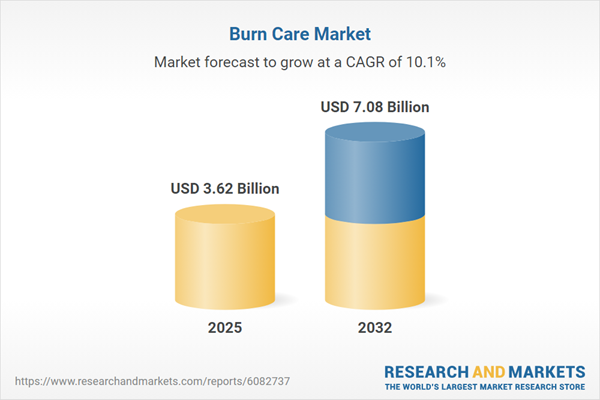Speak directly to the analyst to clarify any post sales queries you may have.
The burn care market is evolving rapidly, shaped by ongoing technological breakthroughs and changing clinical demands. Senior decision-makers must anticipate shifts and develop strategic approaches to capture opportunities in this highly competitive sector.
Market Snapshot: Burn Care Market Growth and Investment Outlook
The burn care market advanced from USD 3.28 billion in 2024 to USD 3.62 billion in 2025 and is projected to reach USD 7.08 billion by 2032, at a 10.09% CAGR. This expansion is enabled by new tissue engineering techniques, digital health integration, and a global turn toward value-based reimbursement frameworks. Increasing severe burn cases—across both established and emerging economies—heighten the urgency for scalable, affordable solutions. Companies are prioritizing innovation to overcome operational hurdles and shifting reimbursement structures, focusing on distinctive products that respond directly to growing market needs.
Scope & Segmentation: Comprehensive Overview of the Burn Care Market
This report delivers a structured analysis of the core segments, stakeholders, and geographic distinctions driving change across the burn care landscape. Each segment plays a vital role in the decisions senior leaders make about adoption, strategy, and resource allocation.
- Product Types: Laser therapy devices, wound vacuum assisted closure systems, alginate dressings, film dressings, foam dressings, hydrocolloid dressings, hydrogel dressings, allografts, autografts, synthetic skin substitutes, and xenografts, covering traditional and advanced care approaches.
- Treatment Types: Both non-surgical methods, such as pharmacotherapy and dressing application, and surgical procedures, including debridement and skin grafting, supporting individualized recovery pathways.
- Burn Degrees: Care plans for first-degree, second-degree, and third-degree burns, each requiring specialized management to optimize outcomes and resource use.
- End Users: Ambulatory surgical centers, burn care clinics, hospitals, and homecare environments, reflecting different channels of adoption and varying requirements for infrastructure and skillsets.
- Distribution Channels: Hospital pharmacies and retail pharmacies, spanning chain and independent models, affecting both reach and product availability for stakeholders.
- Regional Coverage: Key regions include the Americas, Europe, Middle East, Africa, and Asia-Pacific, with a spotlight on high-impact markets such as the United States, Germany, China, India, Brazil, and Australia.
- Key Players: Major industry contributors include B. Braun SE, Cardinal Health, Cipla Limited, Coloplast, ConvaTec, Airgas, DeRoyal Industries, Hollister, Integra LifeSciences, Johnson & Johnson Services, Medline Industries, Molnlycke Health Care, Orkla Group, Paul Hartmann AG, Pfizer, Smith & Nephew PLC, Boiron, Anika Therapeutics, Advanced Medical Solutions Group, Safe N Simple LLC, Triage Meditech, FIBROHEAL WOUNDCARE, 3M, and Dr. Sabharwal's Mfg. Labs.
Key Takeaways: Strategic Insights Shaping the Burn Care Market
- Advancements in wound management and digital health tools are enhancing patient-centric care, streamlining intervention timelines, and improving patient throughput.
- Adoption of telemedicine and remote monitoring technologies is enabling more flexible care delivery and fostering higher levels of patient engagement across diverse settings.
- Shifts in reimbursement policies are motivating organizations to strengthen efficiency and optimize pricing, influencing decisions around product launches and regional strategies.
- Strengthened collaboration between device manufacturers, pharmaceutical partners, and contract suppliers is fast-tracking the introduction of innovative grafts and skin substitutes.
- Increasing advocacy and clinician awareness are spurring demand for reduced invasiveness, alternative pain management, and individually tailored rehabilitation protocols.
- Regional variations in healthcare access highlight the importance of public-private partnerships and targeted expansion strategies to drive growth and transition to scalable care solutions.
Tariff Impact: Navigating the U.S. Burn Care Supply Chain in 2025
Updates to U.S. tariff policy have influenced sourcing and logistics dynamics, resulting in higher procurement expenses for burn care products. Organizations are turning to reshoring efforts and deepening relationships with domestic suppliers to safeguard supply continuity and stabilize costs. Regulatory agencies have granted targeted relief for therapies categorized as critical, supporting the sector's stability. Companies are accordingly reassessing R&D directions and strategic alliances in response to the broader economic landscape.
Methodology & Data Sources
This research leverages structured interviews with burn surgeons, clinical experts, and procurement leads. Findings are supported by secondary analysis from scientific literature, regulatory filings, and corporate disclosures, with data validation and triangulation ensuring accuracy for all market assessments.
Why This Report Matters: Strategic Advantages for Decision-Makers
- Enables executives to optimize burn care technology adoption, regional expansion initiatives, and engagement with developing reimbursement models through robust analysis.
- Offers clear direction for supply chain resilience, improved market access, and the creation of patient-focused care environments.
- Delivers industry benchmarks on innovation and risk mitigation to support leadership during evolving regulatory and economic conditions.
Conclusion
Decision-makers are equipped with a precise, actionable perspective on burn care market evolution, supporting strategic planning and operational excellence in a rapidly advancing field.
Table of Contents
3. Executive Summary
4. Market Overview
7. Cumulative Impact of Artificial Intelligence 2025
Companies Mentioned
The companies profiled in this Burn Care market report include:- B. Braun SE
- Cardinal Health, Inc.
- Cipla Limited
- Coloplast A/S
- ConvaTec Group PLC
- Airgas, Inc.
- DeRoyal Industries, Inc.
- Hollister Incorporated
- Integra LifeSciences Corporation
- Johnson & Johnson Services, Inc.
- Medline Industries, Inc.
- Molnlycke Health Care AB
- Orkla Group.
- Paul Hartmann AG
- Pfizer Inc.
- Smith & Nephew PLC
- Boiron, Inc.
- Anika Therapeutics, Inc.
- Advanced Medical Solutions Group PLC
- Safe N Simple LLC.
- Triage Meditech Pvt. Ltd.
- FIBROHEAL WOUNDCARE PVT. LTD
- 3M Company
- M/s Dr. Sabharwal's Mfg. Labs Ltd.
Table Information
| Report Attribute | Details |
|---|---|
| No. of Pages | 196 |
| Published | November 2025 |
| Forecast Period | 2025 - 2032 |
| Estimated Market Value ( USD | $ 3.62 Billion |
| Forecasted Market Value ( USD | $ 7.08 Billion |
| Compound Annual Growth Rate | 10.0% |
| Regions Covered | Global |
| No. of Companies Mentioned | 25 |









